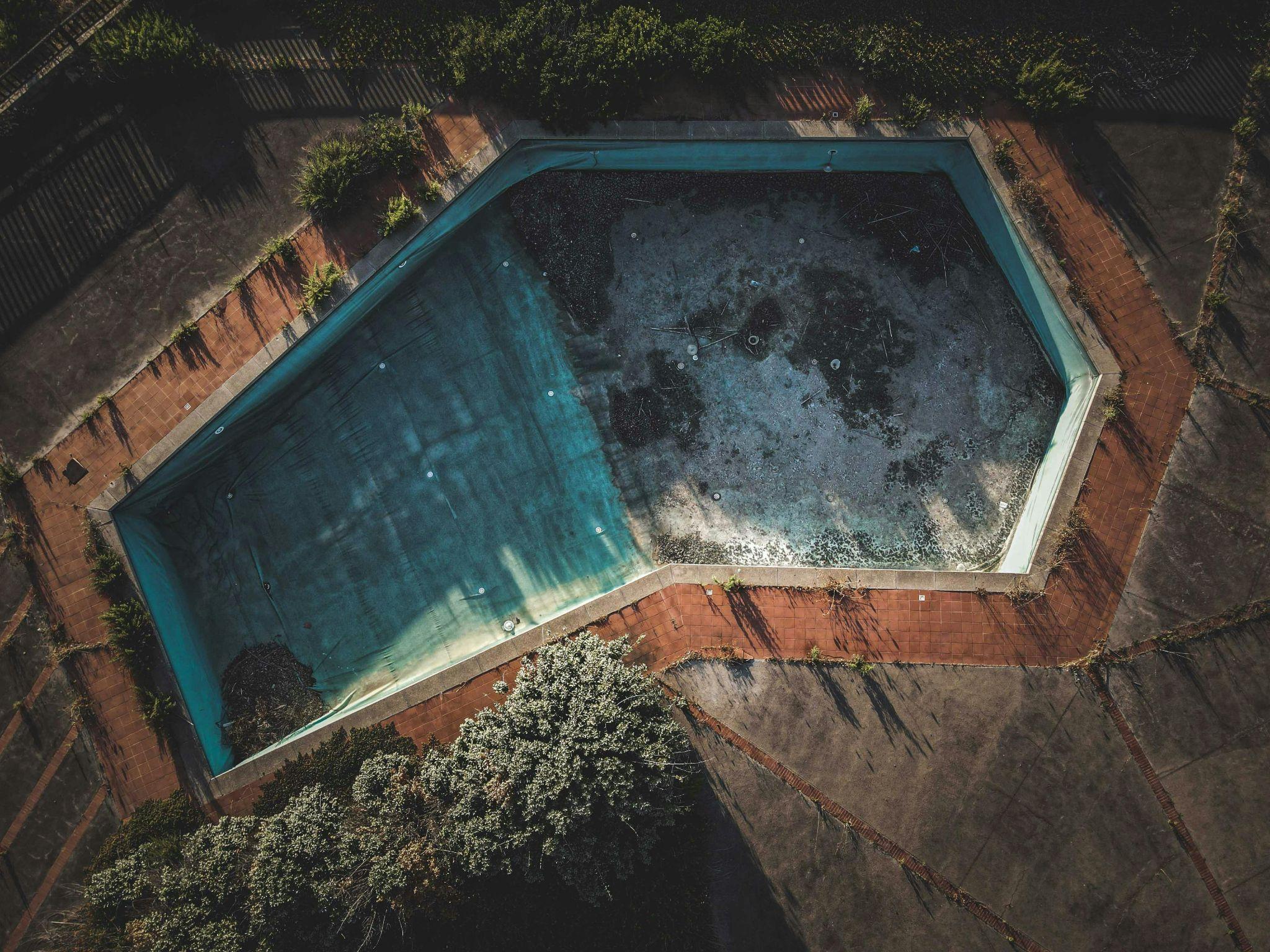Maintaining a pristine swimming pool goes beyond aesthetic appeal—it’s essential for swimmer safety, equipment longevity, and overall water quality. While regular skimming and chemical balancing are part of routine maintenance, certain warning signs indicate your pool requires professional deep cleaning. According to the Centers for Disease Control and Prevention, proper pool maintenance prevents recreational water illnesses and ensures a safe swimming environment. Recognizing these indicators early can save you from costly repairs and health hazards.
Cloudy or Discolored Water
Crystal-clear, light blue water represents the gold standard for pool health. When your pool water appears cloudy, murky, or develops a greenish tint, immediate action is necessary. This discoloration typically signals underlying problems such as algae growth, chemical imbalances, or filtration system failures. Beyond the unsightly appearance, these conditions create breeding grounds for harmful bacteria and can damage your pool’s equipment, including pumps, filters, and heating systems.
| Water Appearance | Likely Cause | Potential Risk |
|---|---|---|
| Milky/Cloudy | Chemical imbalance or filtration issues | Bacterial growth, reduced visibility |
| Green tint | Algae presence | Health hazards, slippery surfaces |
| Yellow/Brown | Metal oxidation or organic matter | Staining, equipment corrosion |
| Gray/Black | Severe algae or mold | Structural damage, serious health risks |
Persistent Cloudiness Despite Chemical Treatment
When your pool water remains cloudy even after shocking and balancing pH levels, deeper mechanical or structural issues may be at play. This persistence often indicates problems with the filtration system, circulation inadequacies, or buildup of microscopic particles that standard treatments cannot address. A professional inspection becomes crucial to diagnose whether you’re dealing with filter media deterioration, pump inefficiency, or calcium scaling within your plumbing system.
Green or Yellow Tint Indicating Algae Presence
Algae transforms your pool into a hazardous environment quickly. Green algae creates slippery surfaces on steps and walls, while yellow (mustard) algae clings stubbornly to shaded areas. Both varieties multiply rapidly in warm conditions and can cause skin irritation, ear infections, and respiratory problems. When algae colonization reaches visible levels, standard chlorination proves insufficient. Professional acid washing or drain-and-clean procedures become necessary to eliminate spores embedded in porous surfaces and prevent immediate recontamination.
Unpleasant Odors
A properly maintained pool should smell neutral or have only a faint chlorine scent. Strong chemical odors, musty smells, or sewage-like scents indicate serious contamination issues. These odors stem from bacterial overgrowth, algae decomposition, or stagnant water harboring organic matter. The Environmental Protection Agency notes that improper water chemistry can create harmful disinfection byproducts. Immediate deep cleaning combined with comprehensive chemical treatment eliminates these contaminants before they compromise swimmer health.
Strong Chlorine-Like or Musty Smells
Ironically, that overpowering “chlorine smell” doesn’t indicate too much chlorine—it signals chloramines, which form when chlorine binds with contaminants like sweat, urine, and body oils. These compounds cause eye irritation, respiratory discomfort, and that characteristic indoor pool smell. Musty odors typically indicate biofilm development—colonies of bacteria protected by a slimy matrix that standard sanitizers cannot penetrate. Addressing these issues requires shock treatments at 10 times the normal chlorine level, improved ventilation for indoor pools, and potentially draining sections of water to reduce chloramine concentration.
Visible Algae Growth

Algae manifests as colored patches—green, yellow, or black—clinging to pool surfaces, floating in water, or accumulating in corners and crevices. Beyond the obvious aesthetic problems, algae creates multiple hazards:
- Health risks: Skin rashes, eye infections, and gastrointestinal issues from ingestion
- Safety hazards: Extremely slippery surfaces increasing fall and drowning risks
- Equipment damage: Clogged filters and reduced circulation efficiency
- Chemical resistance: Established colonies require exponentially more sanitizer to eliminate
Professional deep cleaning becomes essential when algae growth reaches visible levels. Technicians employ specialized brushes, powerful vacuums, and concentrated treatments to remove algae from every surface, including hard-to-reach areas behind ladders and beneath pool covers.
Algae Reappears After Treatment
Recurring algae blooms despite treatment indicate systemic problems rather than temporary contamination. This pattern suggests inadequate filtration capacity, circulation dead zones where water stagnates, phosphate accumulation providing algae nutrients, or sanitizer demand exceeding your chemical dosing regimen. A comprehensive professional evaluation examines water chemistry, equipment performance, and pool structure to identify why your sanitization efforts fail. This assessment often reveals the need for filter upgrades, circulation system modifications, or specialized treatments targeting algae spores dormant in your pool’s infrastructure.
Excessive Debris Accumulation
While leaves, insects, and occasional debris are normal, excessive accumulation signals maintenance inadequacy. Heavy debris loads:
- Clog skimmer baskets and pump strainers
- Overwhelm filtration systems
- Decompose into organic compounds that feed algae
- Create anaerobic zones harboring harmful bacteria
- Scratch and stain pool surfaces
When debris covers significant portions of your pool floor or floats densely on the surface, thorough cleaning becomes necessary before the material breaks down and creates water quality problems.
Debris Accumulation After Storms or Heavy Use
Following storms, high winds, or pool parties, debris levels spike dramatically. Storm runoff introduces dirt, leaves, and potentially contaminated water into your pool. Heavy swimmer loads deposit oils, lotions, and organic matter. These situations demand immediate attention—waiting allows debris to decompose and integrate into your water chemistry, making removal exponentially more difficult. Post-storm protocols should include checking skimmers and pump baskets for blockages, brushing surfaces before debris settles, and shock treating to address contaminant overload.
Equipment Struggles to Maintain Water Clarity
Modern pool equipment should effortlessly maintain crystal-clear water when functioning properly. If your pump runs continuously, filters require frequent cleaning, or water clarity deteriorates despite equipment operation, deeper cleaning addresses accumulated problems beyond your system’s current capacity. Equipment struggles often indicate:
| Equipment Issue | Possible Cause | Solution Required |
|---|---|---|
| Weak water flow | Filter clogging or pipe blockages | System flush and deep clean |
| Short filter cycles | Heavy contamination load | Backwashing and media replacement |
| Pump overheating | Restricted circulation | Professional system evaluation |
| Pressure irregularities | Internal scaling or debris | Chemical cleaning or component replacement |
Persistent Cloudiness Despite Equipment Operation
When your circulation system runs properly but water remains cloudy, the problem exceeds mechanical solutions. Microscopic particles, dissolved solids, or biofilm within your plumbing may require specialized treatment. Professional technicians employ flocculation chemicals that bind tiny particles into larger, filterable clumps, enzyme treatments that digest organic buildup, or system purging that flushes accumulated contaminants from pipes and equipment. Delaying professional intervention risks permanent equipment damage and necessitates costly component replacement.
Conclusion
Recognizing these five critical signs—cloudy or discolored water, unpleasant odors, visible algae growth, excessive debris accumulation, and struggling equipment—enables proactive pool maintenance before minor issues escalate into major problems. Regular monitoring combined with prompt professional deep cleaning when these indicators appear ensures your pool remains a safe, inviting, and enjoyable retreat. Don’t wait until water quality deteriorates beyond recovery; address warning signs immediately to protect your investment, safeguard swimmer health, and maintain the pristine condition that makes pool ownership rewarding.

